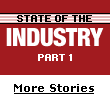
 The good news this year for Brazil, South America’s largest auto industry, is that it expects to manufacture 2.1 million vehicles, a level not seen since 1997 when 2,069,703 cars and trucks were built.
The good news this year for Brazil, South America’s largest auto industry, is that it expects to manufacture 2.1 million vehicles, a level not seen since 1997 when 2,069,703 cars and trucks were built.
The bad news is domestic sales are estimated at 1.54 million units, which, although representing a 7.8% increase over prior year’s 1.43 million, still is a far cry from the record 1.97 million sales in 1997. A growing export market is taking up the slack.
And while Brazilian auto makers continue to strive for the brass ring, the general consensus is domestic sales will continue to remain soft in 2004 and 2005 (1.6 million), despite a reviving economy.
Ray Young, president of General Motors do Brasil Ltda., blames the weak market on high interest rates, compared with other countries. He also warns short supplies and rising prices for raw materials, especially steel, could add to industry troubles next year.
Hyperinflation and high lending rates historically have been an issue for Brazil, whose citizens stagger under a tax burden nearly 40% of the country’s gross domestic product. Indeed, fears of rising inflation forced the central bank in September to hike rates once again.
Nevertheless, car sales totaled 137,700 units for the month, up 5.5%, says the industry’s manufacturing group, a 10.1% increase over prior year. GM led domestic sales, as it has for most of the year, with 24.5% market share.

Ford EcoSport helped boost South American Sales.
Ford Motor Co.’s South America division recorded a $15 million profit in the year’s first quarter following nine years of losses, crediting Brazil with 70% of its annual sales. Ford Brasil Ltda. expects to produce 200,000 vehicles this year at its plant in Camacari, Bahia, and 250,000 in 2005.
Despite the positive indicators, European auto makers are not pleased; warning investments in 2005 will shrink.
Rogellio Golfarb, president of the National Association of Vehicle Manufacturers (Anfavea), says there is concern among Europeans – whose companies also build and sell cars in Brazil – that a healthy, sustainable domestic market is essential for further investment in the country.
He says Brazilian auto makers in 1997 exported a negligible volume of cars compared with 2004, where exports are expected to account for 25% of total production, competing with, or perhaps cannibalizing, other European models.
Brazil’s auto exports, shipped primarily to the U.S, Argentina and Mexico, totaled $5.85 billion in the first nine months, a 49.5% leap over like-2003. Exports in August, alone, reached a record $773.3 million.
By producing cars for export in Brazil, where salaries and raw materials are far lower, Europeans wonder whether this is a form of friendly fire, reducing exports from their home countries – France, Italy and Germany.
If there is a bright spot for Brazil in 2004, it is the remarkable growth of cars with alcohol-fuel engines, particularly the flex-fuel models that can run on both gasoline and alcohol fuel.
Some 250,000 cars, or 17% of domestic sales, are forecast to be running on flex-fuel engines by year-end. By 2007, nearly 70% of new cars produced are expected to have a bi-fuel engine.

GM Astra offers flex-fuel engine.
Additionally, auto makers are developing a tri-fuel engine that adds natural gas as a third choice. GM Brazil currently offers the largest gamut of flex-fuel models, including the Astra, Corsa, Meriva, Montana and Zafira.
Other flex-fuel vehicles include the Fiat Palio, Weekend and Siena and the Volkswagen Fox. Ford, Peugeot and Citroen brands planned to offer flex-fuel cars in the year’s second half. Renault SA will offer a flex-fuel vehicle in 2005.
While gasoline prices see little change between regions, alcohol-fuel prices vary by more than 150%. In sugar-producing regions of the state of Sao Paulo, alcohol fuel costs 15 cents per liter, compared with 66 cents per liter of gas.
Additionally, new discoveries of natural gas off the coast of Rio de Janiero and Santos are expected to prompt more car owners to convert to natural gas-fueled engines. There currently are close to 800,000 vehicles in the country running on natural gas.
Despite this year’s bump in sales and escalating exports, Brazil’s Big Four (GM, Ford, Volkswagen do Brasil Ltda. and Fiat Automoveis SA), have asked the government to reduce taxes on domestic cars and increase after-sales taxes to equalize the current tax burden and sell more vehicles.
– with Sol Biderman in Sao Paulo




